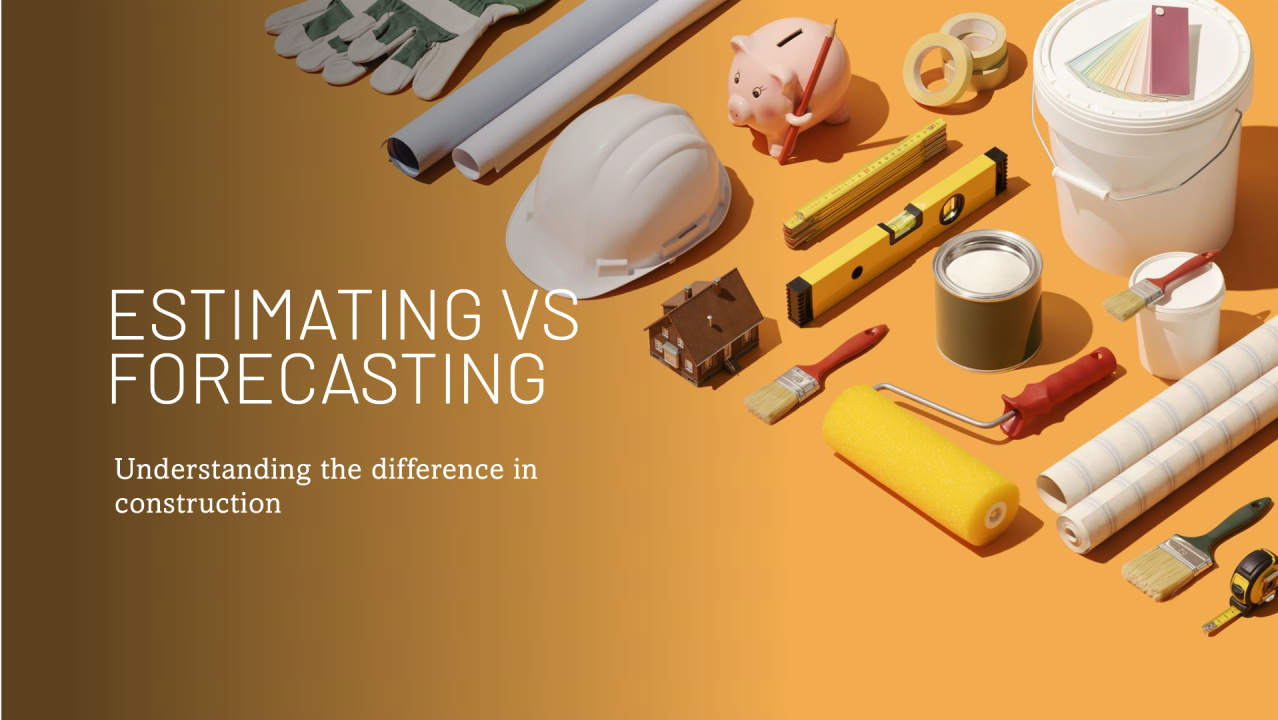In construction, two terms often surface during project discussions: estimating and forecasting. While they may sound similar, estimation and forecasting are distinct processes that use data to make predictions. They differ in scope, purpose, and accuracy. Let’s break them down in simple terms, using relatable analogies and examples to make the concepts engaging and easy to understand.

The Core Difference
Estimating is like planning a road trip: You decide how much gas, food, and money you’ll need to reach your destination based on current prices and a rough idea of the journey.
Forecasting, on the other hand, is what you do mid-trip: You check your fuel gauge, factor in unexpected traffic, or adjust plans for a detour. Forecasting helps you adapt to real-time conditions.
In construction, estimating is about predicting costs before the project begins, while forecasting monitors and adjusts these predictions as the project progresses.
What Is Estimating?
Estimation provides a best guess about the resources, time, and money required for a project. It’s a static snapshot, prepared before work starts.
Key Features of Estimation:
- Goal: To prepare a comprehensive budget and resources plan.
- Basis: Historical data, market prices, blueprints, and specifications.
- Tools Used: Cost estimation software, spreadsheets, and industry databases.
- When It’s Done: During the project planning stage.
Types of Construction Estimates:
- Preliminary Estimates: Rough ballpark figures based on minimal information.
- Detailed Estimates: In-depth calculations considering materials, labor, and contingencies.
- Bid Estimates: Specific quotes provided by contractors to secure a project.
Also Read: Why 3D Printing Is the Next Big Thing in Construction Industry
What Is Forecasting?
Forecasting is a dynamic process that helps project managers stay on track. It’s not about guessing—it’s about adjusting estimates based on real-time data.
Key Features of Forecasting:
- Goal: To ensure the project remains aligned with budget and timeline goals.
- Basis: Current project performance, unforeseen issues, and market changes.
- Tools Used: Project management software, dashboards, and trend analysis.
- When It’s Done: Continuously during project execution.
Why Forecasting Is Crucial:
1. Adaptability: Helps adjust to unexpected issues, like a spike in steel prices or a labor shortage.
2. Risk Mitigation: Identifies potential overruns early, giving time to implement corrective measures.
3. Transparency: Keeps stakeholders informed about the project’s financial health.
Fun Analogies to Understand the Difference
- Estimation: Think of a wedding planner creating a budget for an event.
- Forecasting: On the wedding day, they adjust the plan because it’s raining, and they need to rent a tent.
The Interplay Between Estimating and Forecasting
The two concepts work hand-in-hand, like a relay race. Estimating sets the foundation, while forecasting ensures the baton is passed smoothly as the project unfolds.
Scenario Example: Building a Commercial Complex
Estimation Stage: A detailed estimate predicts the total cost will be $5 million. This includes:
– $2 million for materials.
– $1.5 million for labor.
– $500,000 for permits and approvals.
– $1 million for contingencies and profit margins.
Forecasting Stage: Six months in, unforeseen events occur:
– A sudden rise in concrete prices increases material costs by 15%.
– Weather delays push the timeline by two months, adding labor expenses.
Forecasting identifies these issues and suggests reallocating funds from the contingency budget to cover the additional costs. Without it, the project would likely exceed its budget.
Practical Applications in Construction
1. Using Technology for Estimation and Forecasting
-Tools like BIM (Building Information Modeling) help with precise cost estimates.
– Software like Procore and Oracle Primavera assists with forecasting in real-time.
2. Integrating Both Processes for Better Results
– Start with detailed estimates to set expectations.
– Use forecasting to adapt and ensure project success.
Why Understanding Both Matters
In the fast-paced world of construction, sticking rigidly to an estimate without forecasting is like sailing without checking the weather. Likewise, trying to forecast without a solid estimate is like steering without a map.
By mastering both, construction professionals can:
- Deliver projects on time and within budget.
- Gain the trust of clients and stakeholders.
- Build resilience against market fluctuations and unexpected hurdles.
Conclusion
Estimating and forecasting aren’t rivals—they’re teammates. Together, they create a roadmap that not only helps navigate the project from start to finish but also ensures adaptability along the way. In construction, the ability to estimate and forecast effectively can mean the difference between a project that thrives and one that falters.
So, what’s your take—are you more of an estimator or a forecaster in your projects? Let’s discuss in the comments!
